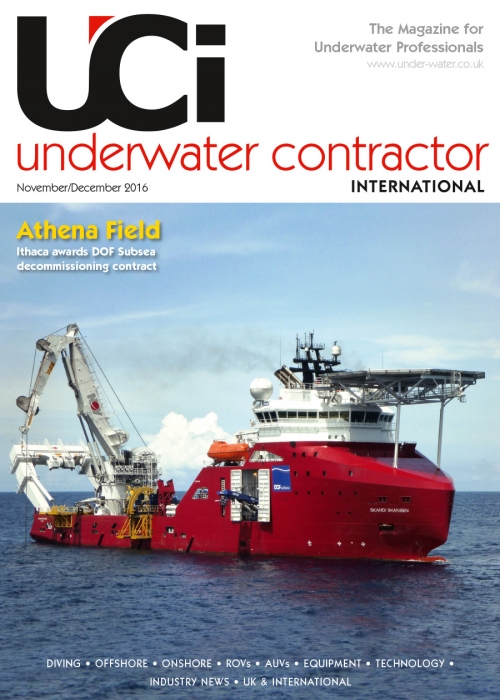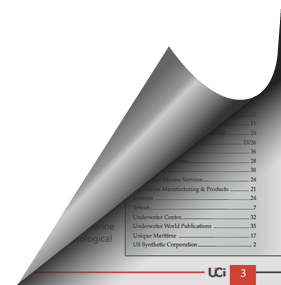
The Magazine for Underwater Professionals
![]() May/Jun 2016
May/Jun 2016
INDUSTRY NEWS - EQUIPMENT & TECHNOLOGY
Atlantas Marine launches video tool for CP surveys
Atlantas Marine has made its first move into ROV instrumentation with the design and manufacture of a video overlay device intended to make cathodic protection surveys easier and faster.
The new tool has been designed to display the readings obtained by a cathodic protection probe as an overlay on the ROV’s video display. This creates a permanent record and eliminates the need for the ROV operator to make handwritten notes of individual probe readings while surveying the condition of a vessel’s anodes, said the UK-based company.
Atlantas said the new CP video overlay tool is the result of many years of practical ROV operation. “Experience of the practical challenges of ROV operation and the company’s high level of in-house technical expertise has resulted in the development of this instrument which can enhance the capabilities of ROVs of any size,” it said.
The CP video overlay unit consists of a small black box that can be quickly interfaced with the ROV’s cathodic measurement probe and the pilot’s video display. “It is the answer to a practical problem that Atlantas Marine ROV operators had been grappling with for many years and it now enables them to give their undivided attention to the task of operating the ROV and its probe,” the company said.
When the ROV is driven forward against the hull or anode of a vessel the current reading obtained by its probe is traditionally displayed on a separate unit. From there it must be transcribed by the ROV pilot or an assistant in a way that enables the reading to be related to a specific anode. This can be a challenge if sea conditions are difficult or visibility is limited but with the CP data overlay it is no longer necessary.
“The reading obtained by the probe is shown as part of the ROV’s video display which is creating a permanent record of the dive. By reviewing the recording later it becomes possible to relate the data to the exact location in a way that efficiently avoids any mistakes or ambiguity,” said Atlantas.
The world’s first ‘real world’ deepwater controlled experiment simulating emission from a submerged carbon dioxide storage reservoir is to take place in the North Sea, with the aim of further verifying the safety of offshore CO2 capture and storage (CCS).
Small quantities of CO2 will be injected into mud on the seafloor in the North Sea, 100 kilometres north east of Aberdeen, Scotland. This site is in the vicinity of a depleted gas field and is a typical location that could be used for carbon dioxide storage.
This first of a kind experiment, due to take place in 2018, will form part of a GB£13 million collaborative project led by the National Oceanography Centre (NOC), UK, which will enable scientists to develop a system for detecting and quantifying the volume of any CO2 released. The work will help provide greater reassurance around the safety of CCS operations in the future.
Project leader Dr Doug Connelly from the NOC said: “Currently, it is challenging to detect and quantify CO2 emissions in the marine environment because of dispersion and attenuation effects, the small volumes involved and considering large existing natural variability. This project is a really exciting opportunity to develop innovative, safe and cost effective technology to address these problems.”
In order to ‘listen’ for the released CO2, the project will be developing acoustic and chemical sensors that can be fitted into robot-subs. Automated photographic analysis software will also be developed to enable the detection of any visual changes at the release site. Additional technology will include devices in the water and on the seabed to monitor changes in the chemistry, temperature, salinity and currents in the water.
EdgeTech, USA, reports the release of the new 2300 combined tri-frequency sidescan sonar, sub-bottom profiling and bathymetry system. The company said the unit combines its highly successful line of sidescan sonars, sub-bottom profilers and multiphase echosounder (MPES) bathymetry into one fully integrated system.
“The new 2300 system is ideal for deepwater combined sonar operations and provides many enhancements to traditional systems,” the firm said. “Utilising EdgeTech’s proven Full Spectrum CHIRP technology to provide crisp, high-resolution imagery, surveyors can choose to operate any two frequencies simultaneously from the versatile tri-frequency system.”
The company said sub-bottom profiler capabilities have been expanded on the system and include the ability to incorporate up to four low frequency transducers as part of its DW-106 (1kHz-10kHz) deep penetration system. Coupled with that is the ability to utilise a large PVDF (polyvinylidene difluoride) hydrophone array, “providing better sub-bottom receive sensitivity and directivity”.
EdgeTech’s MPES bathymetry is also available on the platform. The multiphase echosounder produces real-time, high-resolution, 3D maps of the seafloor while providing co-registered simultaneous dual frequency sidescan imagery.
iXBlue, France, has launched ROVINS NANO, an inertial navigation system designed for ROV navigation.
Based on iXBlue’s ultimate performance fibre optic gyroscope technology, ROVINS NANO has been designed for ROV pilots performing maintenance and construction operations. “It offers the unbeatable stability and accuracy of the inertial position, outputting true north, roll, pitch and rotation rates,” according to the company.


